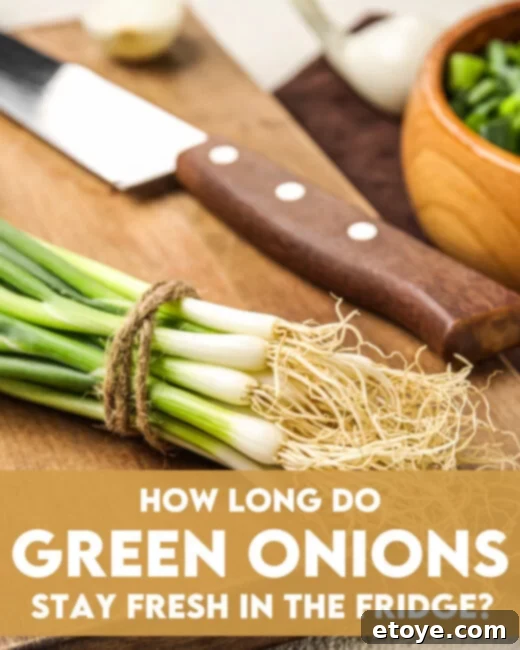“How did we end up here, you and I?”, you whisper, a tinge of regret in your voice. “How long before you decide to wilt away on me, destined for the compost bin?”
No, this isn’t a heart-wrenching scene from a dramatic film. This is a common, relatable moment: you, standing before your refrigerator, perhaps lamenting the fate of a forgotten bunch of vibrant green onions. You remember the excitement when you picked them up at the grocery store, envisioning a myriad of culinary possibilities. Then, they were tucked away into the crisper drawer – that notorious “out of sight, out of mind” zone where so much fresh produce sadly meets its premature end.
Fear not, fellow food enthusiast! You’re not alone in this green onion predicament, and more importantly, there’s a solution. We understand the frustration of food waste and the desire to make the most of every ingredient you bring into your kitchen. At Steamy Kitchen, we’re dedicated to empowering you with the knowledge and techniques to keep your fresh produce at its peak, ensuring those delicious greens nourish your body instead of filling your trash can.
Today, we embark on a comprehensive journey into the world of green onions, also known as scallions or spring onions. We’ll uncover the secrets to their optimal storage, learn how to identify the subtle signs of spoilage, and arm you with creative ways to incorporate them into your cooking. Get ready to transform your approach to these versatile, flavorful stalks and banish wilted, wasted green onions from your life forever. Let’s dive in!
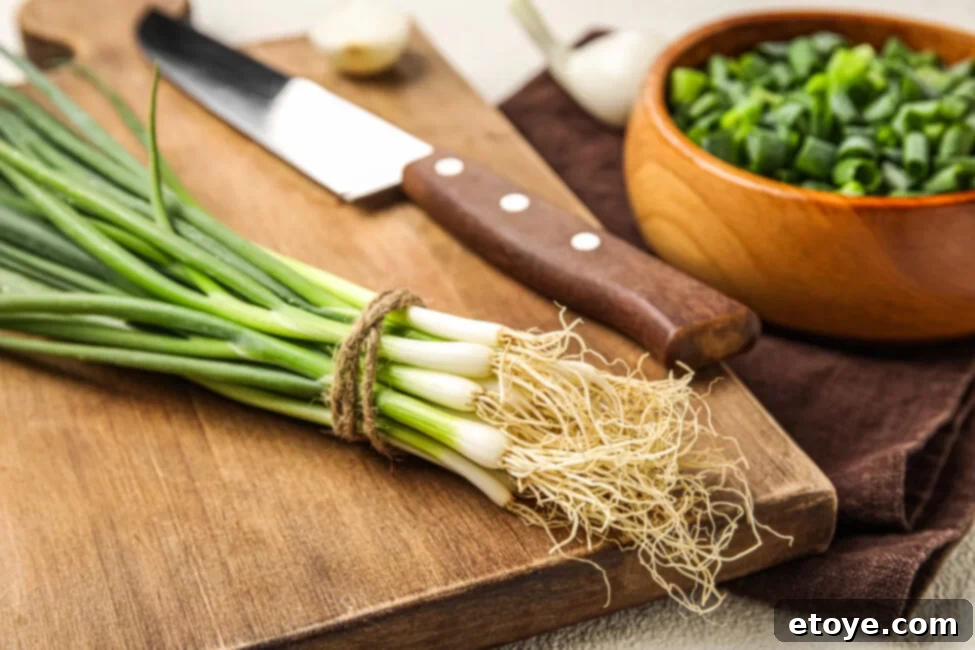
Unlocking the Longevity of Green Onions: Your Ultimate Storage Guide
Green onions are a culinary chameleon, adding a crisp texture, a mild oniony bite, and a pop of vibrant green to countless dishes. But their delicate nature often leads to a short lifespan once brought home. Understanding how to maximize their freshness is key to minimizing food waste and always having this essential ingredient on hand.
The Green Onion Lifespan: What to Expect in Your Fridge
So, exactly how long can you expect your green onions to stay fresh in the fridge? Under the right conditions, these leafy alliums can maintain their crispness and flavor for an impressive 2 to 3 weeks. However, this isn’t a guaranteed timeframe. The true longevity of your green onions – whether you call them spring onions or scallions – hinges significantly on several crucial factors, primarily how meticulously they are stored and handled from the moment they enter your kitchen.
While a few weeks might seem like a decent stretch, a slight misstep in storage can drastically reduce their shelf life, turning them from vibrant green to a limp, yellow mess in just a few days. Knowing what influences their freshness is the first step towards culinary success.
Key Factors That Influence Green Onion Shelf Life
Imagine two identical bunches of green onions, fresh from the market, entering the same refrigerator. Weeks later, one emerges looking as perfect as the day it was purchased, while the other has succumbed to the inevitable fate of wilting and waste. What truly differentiates their destinies? A few critical factors play a pivotal role:
- Their Starting Quality: The Foundation of Freshness
The journey to long-lasting green onions begins at the grocery store. Always select bunches that are vibrant green from tip to root, with firm, unblemished stalks. Avoid any bundles showing signs of wilting, yellowing tips, sliminess, or dark spots. The fresher they are when you buy them, the longer they will last at home. Think of it as building on a strong foundation – compromised produce from the start will degrade much faster, regardless of your storage efforts. - Optimal Storage Practices: A World of Difference
How you prepare and store your green onions is arguably the most impactful factor in extending their shelf life. Proper storage isn’t just about tossing them into a drawer; it involves creating an environment that mimics their ideal growing conditions while preventing the common culprits of spoilage: dehydration and excessive moisture. We’ll delve into specific, highly effective storage methods shortly, but understanding their importance is paramount. - Temperature & Humidity Control: Their Ideal Environment
Green onions are particularly sensitive to both temperature and humidity. Their ideal storage environment is cool and relatively humid, similar to the conditions found in a refrigerator’s crisper drawer. Exposing them to warm temperatures, such as leaving them on the counter for too long, or to very dry air will rapidly accelerate moisture loss, leading to wilting and spoilage. The goal is to keep them cool enough to slow metabolic processes and moist enough to prevent dehydration, but not so wet that they become prone to mold or sliminess. - Gentle Handling: Preventing Premature Damage
These slender, delicate stalks are surprisingly vulnerable to rough handling. Bruising or crushing green onions can damage their cellular structure, leading to quicker deterioration, browning, and sliminess. Always handle them with care, whether you’re transporting them home, washing them, or placing them in storage. A little gentleness goes a long way in preserving their integrity. - Why Room Temperature is Not Their Friend
While some produce can happily reside on your countertop, green onions are not among them. The cooler temperatures of your refrigerator significantly slow down the enzymatic processes that lead to spoilage. At room temperature, green onions will quickly lose their crispness, dry out, and begin to wilt, typically lasting only a day or two before becoming unusable. For anything beyond immediate use, the cool embrace of your fridge is essential.
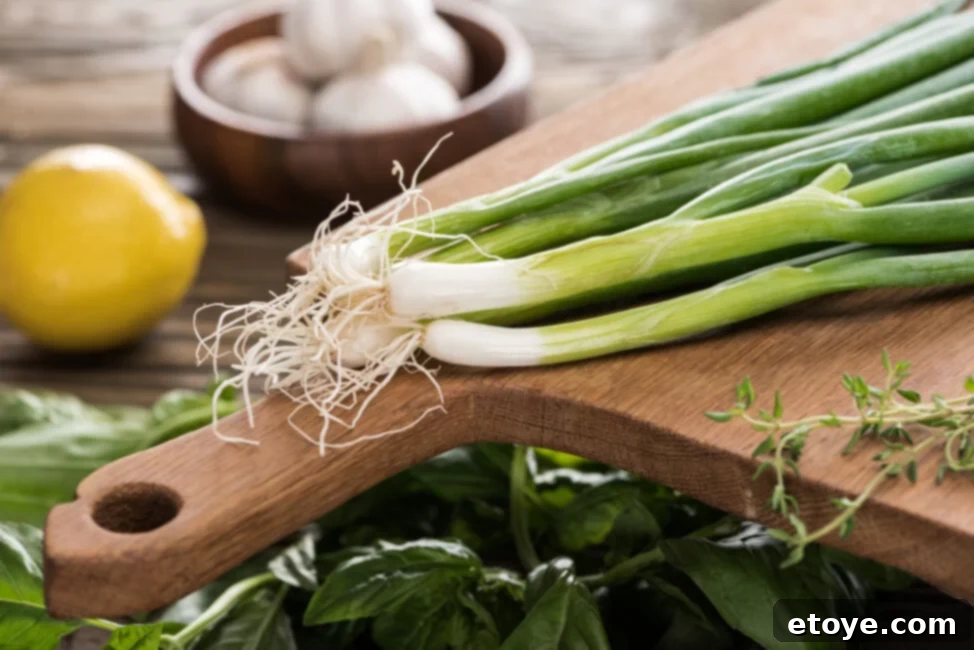
Decoding the Signs: When Your Green Onions Have Gone Bad
No matter how diligent your storage efforts, all fresh produce eventually succumbs to spoilage. Learning to identify the clear signals that your green onions have passed their prime is crucial for both food safety and ensuring the best flavor in your cooking. Trust your senses – they are your best guide from vibrant to vile. Here are the tell-tale signs of spoilage:
- The Nose Knows: Aromatic Alarms
Fresh green onions have a distinct, mildly pungent, and fresh oniony aroma. If your green onions begin to emit a strong, foul, or sulfurous odor, akin to rotting vegetables or old compost, it’s a definitive sign they have gone bad. This off-putting smell is typically caused by bacterial growth, indicating that the breakdown process is well underway. When in doubt, let your nose decide; a truly unpleasant smell means it’s time to discard them. - Trust Your Peepers: Visual Cues of Decline
Visual inspection offers immediate clues. Look for any significant changes from their initial vibrant green. Signs of spoilage include:- Yellowing: Especially on the green tips and upper stalks, this indicates dehydration and age.
- Dark Spots or Discoloration: Black, brown, or mushy spots, particularly on the white parts or where they were cut, are clear indicators of decay.
- Visible Mold: Any fuzzy white, gray, or greenish patches are unambiguous signs of fungal growth, making the entire bunch unsafe to eat. Mold can spread quickly, so even small spots are a red flag.
- Sliminess: A shiny, slick film on the surface suggests bacterial proliferation and decomposition.
- Touch to Confirm: The Texture Test
The texture of fresh green onions should be crisp and firm. As they spoil, they will lose their structural integrity. Green onions heading south will become noticeably limp, soft, and rubbery. If they feel mushy or slimy to the touch, they are definitely past their prime. This loss of crispness is a primary indicator of moisture loss and cellular breakdown.
And as always, when it comes to any perishable food item, never risk inviting foodborne illnesses. If you observe any of these signs, or even if you simply have a lingering doubt about their freshness, the safest course of action is to throw them out. Your health is not worth the risk.
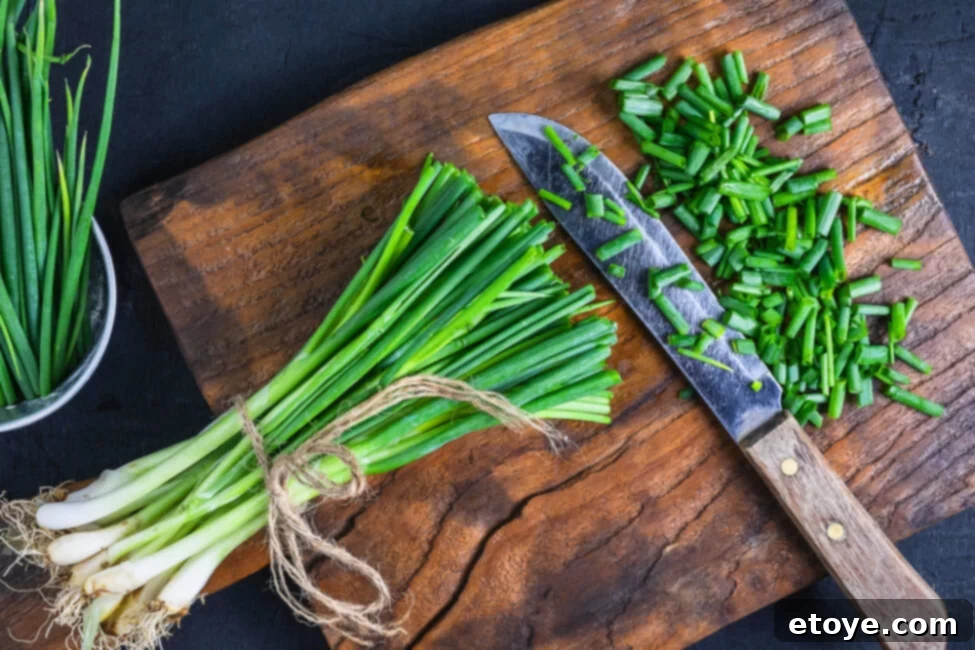
Mastering Freshness: The Best Ways to Store Your Green Onions
Here’s the exciting part: with just a little bit of care and the right method, extending the life of your green onions is incredibly easy! There are several tried-and-true techniques, each with its own advantages, ensuring you always have fresh scallions ready for your culinary creations.
General Preparation for All Storage Methods:
Before implementing any of the following storage methods, a little prep can go a long way:
- Inspect and Clean: Carefully check your green onions for any damaged, yellowed, or slimy outer layers and remove them. Gently rinse the remaining stalks under cool water to remove any dirt.
- Thoroughly Dry: This is crucial! Excess moisture on the surface can lead to sliminess and mold. Pat them thoroughly dry with paper towels or use a salad spinner to remove as much surface water as possible.
Top Storage Methods:
- 1. The Jar Method (Ideal for Rooted Green Onions)
This method is fantastic for green onions that still have their roots intact, and it even allows for some regrowth!- Preparation: Trim any excess roots if they are very long, but ensure enough remains to absorb water. Remove any rubber bands.
- Water & Jar: Pour about an inch of fresh, cool water into a tall glass or a Mason jar. The water should cover just the roots and the very bottom of the white bulb.
- Place Green Onions: Stand your green onions upright in the glass or jar, ensuring the roots are submerged.
- Cover (Optional but Recommended): For added protection and to create a humid microclimate, gently place a loose-fitting plastic bag (like a freezer bag) over the top of the entire setup. Do not seal the bag tightly; you want some air circulation.
- Refrigerate: Place the glass with the green onions in your refrigerator.
- Maintenance: Crucially, change out or refill the water every 1-2 days to prevent bacterial growth and keep the onions hydrated. If the water becomes cloudy or smelly, change it immediately.
Benefits: Keeps green onions crisp for up to 2-3 weeks, and the roots can even sprout new green growth, offering a continuous supply!
- 2. The Root Wrap Method (Excellent for Uncut Green Onions)
This method focuses on maintaining just the right amount of moisture around the roots and stalks without submerging them.- Preparation: As above, clean and thoroughly dry your green onions.
- Damp Paper Towel: Take a paper towel and dampen it slightly – it should be moist, not dripping wet.
- Wrap Roots: Wrap the damp paper towel securely around the white root ends and the lower part of the green stalks.
- Container or Bag: Place the wrapped green onions into an airtight container or a large, sealable plastic bag (such as a Ziploc bag).
- Seal (Loosely): If using a bag, don’t seal it completely airtight; leave a small gap for minimal air circulation to prevent excessive humidity, which can lead to sliminess. If using a container, ensure the lid is snug but not vacuum-sealed.
- Refrigerate: Store in the crisper drawer of your refrigerator.
Benefits: This method typically keeps green onions fresh for up to 3 weeks. Many find it less maintenance-intensive than the jar method, as you don’t need to change water daily. From personal experience, I often find this to be the most reliable option for consistent freshness.
- 3. The Cut & Wrap Method (Convenient for Pre-Portioned Use)
If you prefer to have your green onions ready to go, or if you plan to regrow the roots, this method is highly effective for longer-term storage of the green tops.- Preparation: Remove any rubber bands. Rinse and thoroughly pat the green onions dry.
- Separate Roots: Cut off the white root ends (at about an inch above the roots) and set them aside if you plan to regrow them.
- Chop or Halve: Cut the remaining green stalks into desired lengths, usually in half, so they fit easily into a zip-top bag or container.
- Dry Excess Moisture (Again): Gently pat the cut green onions again with a dry paper towel to absorb any additional surface moisture.
- Wrap Bundles: Divide the cut green onions into smaller bundles and wrap each bundle loosely in a dry paper towel. This absorbs condensation and helps maintain crispness.
- Bag & Refrigerate: Place the paper-towel-wrapped bundles into a sealable plastic bag (like a Ziploc) or an airtight container. Seal the bag, pressing out as much air as possible, and place them in your crisper drawer.
Benefits: This method is reported to keep your green onion tops fresh for an impressive 4-5 weeks! It’s also incredibly convenient as they are pre-prepped for use. Plus, the separated rooted bulbs can be placed in a glass of water on a windowsill to regrow new green onions – just remember to change that water every couple of days to prevent bacterial growth and sliminess.
- 4. The Freezer Method (For Long-Term Storage)
Did you know you can freeze green onions to keep them fresh for several months? While their texture might soften slightly upon thawing, frozen green onions are perfect for cooked dishes.- Preparation: Thoroughly rinse and pat your green onions completely dry. This is paramount, as excess moisture will lead to ice crystals and freezer burn.
- Chop: Chop the green onions into your desired pieces. Smaller pieces are generally better for cooking from frozen.
- Flash Freeze (Recommended): For best results, spread the chopped green onions in a single layer on a parchment-lined baking sheet. Place the baking sheet in the freezer for 1-2 hours until the pieces are individually frozen. This prevents them from clumping together.
- Transfer to Bag: Once flash-frozen, transfer the green onions to a freezer-safe zip-top bag or an airtight freezer container. Press out as much air as possible before sealing.
- Label & Store: Label the bag or container with the date. Your frozen green onions will last 3 to 4 months.
- Alternative (Direct Freeze): If you skip flash-freezing, you can place the chopped green onions directly into a freezer bag. Freeze for about an hour, then give the bag a good shake to break up any clumps, and return to the freezer.
One Note: Frozen green onions are best used directly in cooked dishes (soups, stews, stir-fries, omelets) rather than as a fresh garnish. The freezing and thawing process can slightly alter their crisp texture, making them less ideal for raw applications.
Creative Ways to Use Up Your Green Onions Before Their Prime
At Steamy Kitchen, we are passionate about minimizing food waste! Before your perfectly stored green onions even think about singing the blues, why not incorporate them into something delicious and exciting? Here are some fantastic ways to utilize your green onions, adding flavor and freshness to your meals:
- As a Versatile Topping: Finely chopped green onions are a culinary MVP! Their mild oniony flavor and crisp texture make them a superb garnish for virtually anything. Sprinkle them over baked potatoes, chili, stews, creamy soups (like this Instant Pot Ramen Noodle Soup!), omelets, scrambled eggs, tacos, stir-fries, noodle dishes, grilled meats, and even avocado toast. They add a vibrant finish and a fresh burst of flavor.
- Infused Savory Oil: Elevate your cooking oils by infusing them with green onions. Gently simmer finely chopped green onions in a neutral oil (like canola or grapeseed) over low heat until fragrant and slightly crispy. Strain out the solids, and you’ll have a beautifully aromatic oil perfect for dressings, marinades, drizzling over roasted vegetables, or finishing Asian-inspired dishes. You can also add a pinch of chili flakes for a spicy kick!
- Elegant Garnish: Beyond simple chopping, green onions can transform into stunning garnishes that add visual appeal to your plates. Check out our recipe for how to make Curly Green Onion Garnish! These delicate spirals instantly make any dish look more professional and inviting.
- Flavorful Add-In for Dishes: Don’t limit green onions to just a topping! Incorporate them into the cooking process. Sauté them with other aromatics as a base for stir-fries, soups, or sauces. Add them to frittatas, quiches, savory muffins, or use them in a flavorful compound butter. They can also be a key ingredient in fresh salsas, dips, or pestos for a unique twist.
- Regrow for a Continuous Supply: This is perhaps the most sustainable and satisfying way to “use” your green onions!
- Preparation: Place the white root ends (about 1-2 inches of the white part with roots attached) into a small glass or jar.
- Water & Sunlight: Add just enough water to cover the roots, and place the glass on a sunny windowsill.
- Watch Them Sprout: Within a few days, you’ll see new green shoots emerging from the tops! Change the water every 1-2 days to prevent cloudiness and bacterial growth.
- Harvest & Replant: Once the green shoots are a few inches tall, you can snip them off for use. After a few harvests, or when the roots become very dense, you can transfer your sprouts to a small pot filled with soil for an even more robust and longer-lasting supply. This method provides an almost never-ending source of fresh green onions right from your kitchen!
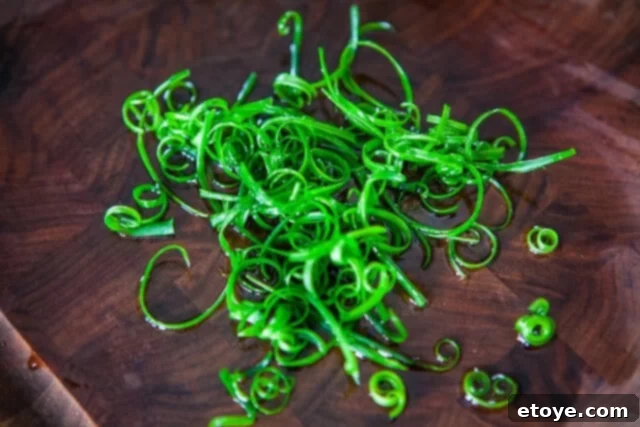
Frequently Asked Questions About Green Onions
Here are answers to some of the most common questions about green onions, helping you become a true expert:
Can you eat the white part of green onions?
Absolutely, you can and should! The white and light green parts of the green onion have a more intense, distinctly onion-y flavor compared to the milder green tops. They are perfect for cooking, adding a deeper aromatic base to your dishes. Many recipes call for separating the white and green parts, using the whites earlier in the cooking process for a stronger flavor release, and the greens as a fresh garnish.
How often should I change the water when storing or regrowing green onions in a glass?
To prevent bacterial growth, sliminess, and to ensure your green onions remain happy and hydrated, it’s essential to refresh the water every 1-2 days. If the water appears cloudy or develops any odor, change it immediately. This simple step is vital for the success of the jar storage and regrowth methods.
Are green onions and scallions the same thing?
Yes, they are indeed the same plant! “Green onions” and “scallions” are interchangeable terms used to describe the same young, immature onion before a bulb has fully formed. In some regions, they might also be referred to as “spring onions,” although “spring onions” can sometimes imply a slightly more developed, though still small, bulb.
Can green onions be grown indoors?
Definitely! Green onions are excellent candidates for indoor gardening. With enough water (for initial regrowth from root ends) and sufficient sunlight, you can easily grow them on a windowsill or under a grow light. Once the roots are established from the water method, transferring them to a small pot with potting soil will allow them to grow more robustly and provide a longer-lasting supply.
Are green onions nutritious?
Yes, they are! Green onions are low in calories but rich in vitamins and minerals. They are a good source of Vitamin K, which is important for blood clotting and bone health, and Vitamin C, an antioxidant. They also contain smaller amounts of Vitamin A, folate, and iron. Like other alliums, they contain beneficial sulfur compounds that contribute to their unique flavor and potential health benefits.
Now You’re a Green Onion Guru!
We hope this comprehensive guide has equipped you with valuable insights and practical tips on how to keep your fresh green onions at their best, saving you money and enhancing your culinary creations. No more dramatic fridge scenes for you!
Now, it’s your turn to share your wisdom! Leave us a comment below with your favorite ways to use up green onions, any secret family recipes that feature them, or your own ingenious step-by-step instructions on how you keep green onions fresh and vibrant. We love hearing from our community!
Want More Fridge & Freezer Tips to Extend Produce Life?
- How Long Does Lemon Juice Last in the Fridge?
- How Long Does Ginger Last in the Fridge and Freezer?
- How Long Do Green Beans Last in the Fridge and Freezer?
- How Long Does Shredded Chicken Last in the Fridge?
